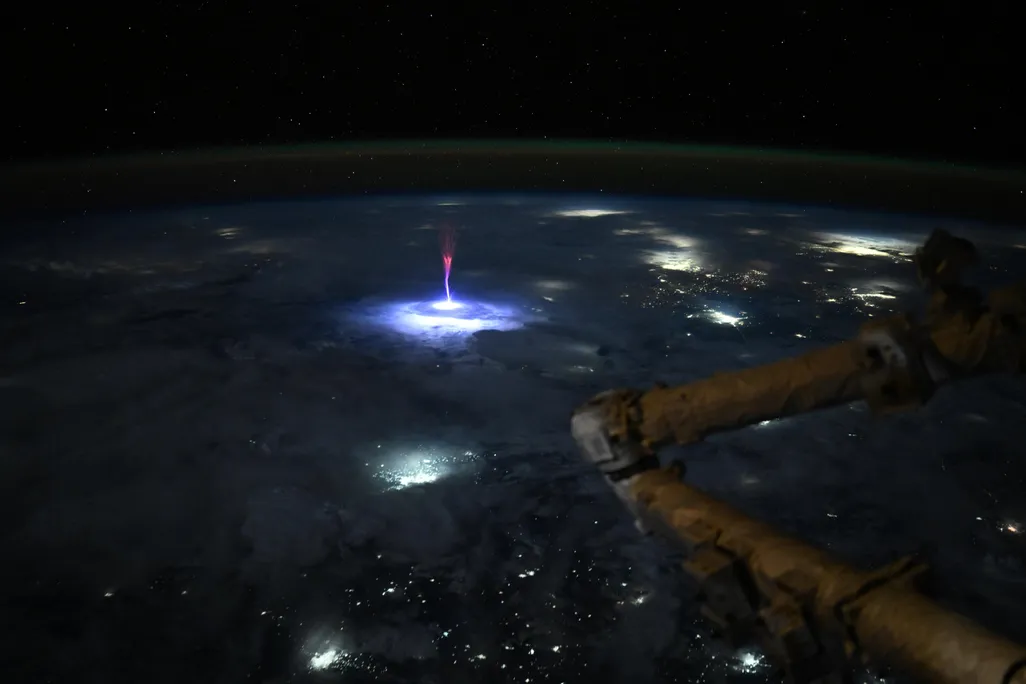Mysterious ‘Red Sprite’ Appears in NASA Astronaut Photo From the Space Station. What Is This Strange Electrical Flare?
Red sprites are among a class of enigmatic weather phenomena that appear over thunderstorms, known as Transient Luminous Events

A NASA astronaut captured an image of a giant “red sprite” from space earlier this week, and the jellyfish-looking result is stunning.
Nichole Ayers, an American astronaut currently aboard the International Space Station (ISS) snapped the image as a storm passed over Mexico and the southern United States. “Just. Wow,” Ayers wrote in an Instagram post on July 3, sharing the photograph.
Red sprites are one category of Transient Luminous Events (TLEs), or short-lived flashes of light that appear high above thunderstorms. Sprites, specifically, show up in the moments after a lightning strike, according to NASA, and they range in size and shape. Their red color comes from the interaction of molecular nitrogen with the positively charged lightning, causing an electrical breakdown that leads to a red flash.
“TLEs are mysterious, beautiful, and uniquely different from conventional lightning, yet they connect weather, space and electricity in one dramatic moment,” explained Hailiang Huang, a researcher at the University of Science and Technology of China who has studied the phenomenon, to Isabel Swafford at National Geographic in June. “They occur high above the clouds, almost silently, and are invisible to most people—but they reflect powerful processes unfolding deep within thunderstorms.”
Need to know: What are red sprites?
After a lightning strike, red sprites may appear in Earth’s mesosphere, high above a thunderstorm. They flash as glowing plumes and spindles for just a fraction of a second, and scientists aren’t exactly sure about how or why they form.
As a sign of their whimsical and enigmatic nature, TLEs are called all sorts of fantastical names by scientists—elves, trolls, jets and ghosts, for instance. But sprites are the most often seen, captivating their observers.
According to NASA, eyewitness reports of sprites date back hundreds of years. But it wasn’t until 1989 that they were photographed for the first time—completely by accident. Researchers at the University of Minnesota were testing a camera for a rocket flight, and they snapped a photo of a sprite by pure luck.
“It wasn’t a very high resolution or fast camera—they just captured two luminous blobs above a nearby thunderstorm,” said Burcu Kosar, a NASA space physicist studying sprites, in a 2022 post from the agency. “The whole field was kickstarted because a camera was pointed in the right direction at the right time.”
Still, many questions remain about TLEs. Because they’re so short-lived and happen at high altitudes, these events are hard to study. Kosar is currently leading NASA’s Spritacular project in hopes of getting some answers. Launched in 2022, Spritacular is a citizen science initiative that aims to build an image database of TLEs. Armed with the data, scientists can hopefully uncover patterns and new information about this mysterious phenomenon. So far, the project has received over 360 observations from more than 870 volunteers across 21 countries.
Images from the ISS, like the one snapped by Ayers, could offer scientists a unique perspective. “We have a great view above the clouds,” Ayers writes on Instagram, “so scientists can use these types of pictures to better understand the formation, characteristics and relationship of TLEs to thunderstorms.”
Researchers are also trying to understand the impact of climate change on the occurrence of sprites, reported National Geographic.
“Rising global temperatures due to climate change will impact thunderstorm intensity and frequency, this will also lead to stronger lightning activity, all of which are precursors for TLE activity,” Kosar said to the outlet. “Details are still an active area of research, but studying TLEs could become even more important for tracking how our atmosphere is changing.”
/https://tf-cmsv2-smithsonianmag-media.s3.amazonaws.com/accounts/headshot/Sara_-_Headshot_thumbnail.png)
